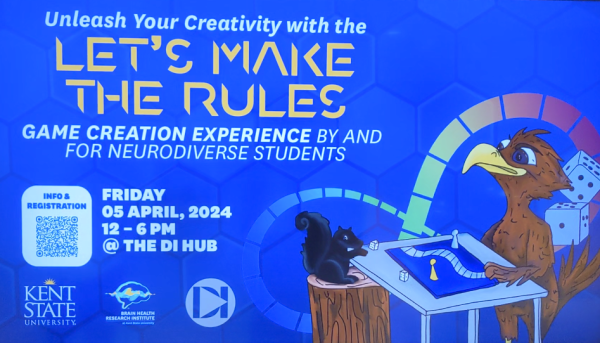Polymer wiggles toward scientific discovery
July 14, 2017
A Kent State professor helped research a new material that can propel itself forward with light.
Robin Selinger, a chemical physics professor at the Liquid Crystal Institute, was among eight researchers who published findings on June 29 about a photoactive polymer film.
“My role in the project was to explain how and why the material behaved the way it does,” Selinger said.
A graduate student, Anne Hélène Gélébart did most of the sample preparation and testing while under supervision of her professor, Dirk Broer, at Eindhoven University of Technology in the Netherlands.
“All the experimental study was done here in Eindhoven, and all the theoretical part was done by the (Kent State team),” Gélébart said.
In Gélébart’s experiments, Selinger’s responsibility was modeling the graduate student’s findings.
She and her fellow researchers found oscillating materials, which adapt their shapes, are becoming more useful in the interest of medicine and robotics.
Selinger gave an example of how robotics could use a similar device: If a robot picked up an egg, it would have to be firm enough to hold the egg but gentle enough not to crack it. Also, the device is powered by light, which could be one day used for robotics in place of batteries.
“In the paper, we discussed a few applications,” Gélébart said. “For self-cleaning surfaces in dry environments or for transport of small objects in remote places.”
The small device is the world’s first soft polymer actuator capable of autonomous locomotion, with no external battery or control system, powered entirely by incident light. When illuminated the strip is able to walk on its own at a speed of about a half a centimeter per second, and it looks like a caterpillar.
While the first step was finding the device was able to move on its own when exposed to light, scientists may still research further possibilities.
“The next step would be to try to optimize the device,” Selinger said. “(Gélébart) might change the dimensions — she might find it goes faster if you use a longer or a shorter ribbon — or narrower or wider ribbon. It might be that the shape of the frame needs to change. Maybe it’ll work better if it’s on a much narrower frame rather than a wide one.”
The polymer may possibly flip over on its own to change direction, Selinger said. Finding a way to change the chemistry of the device may make it respond to solar light as opposed to exclusively ultraviolet light.
Gélébart added another possible step would be to see if it can be used in a liquid environment.
Maddie Wilson, senior applied engineering major, said new technology like this device is what engineers and engineering students live for.
“I think it is super cool and could really be used in the field of engineering,” Wilson said. “I don’t know how robotics would use it right now, but for sure it will be used when the need arises.”
Selinger said her work would not be possible without the state of Ohio funding the Ohio Supercomputer Center — which is located in Columbus — because without the center making high-performance computing available to researchers at universities across the state, she would not have the computing resources needed for the polymer project.
Her work was also supported by a grant from the National Science Foundation.
“I am tremendously grateful for the support that I’ve received,” Selinger said. “The National Science Foundation has made a huge impact on my ability to (study) science.”
Ray Padilla is the academics reporter. Contact him at [email protected].


























